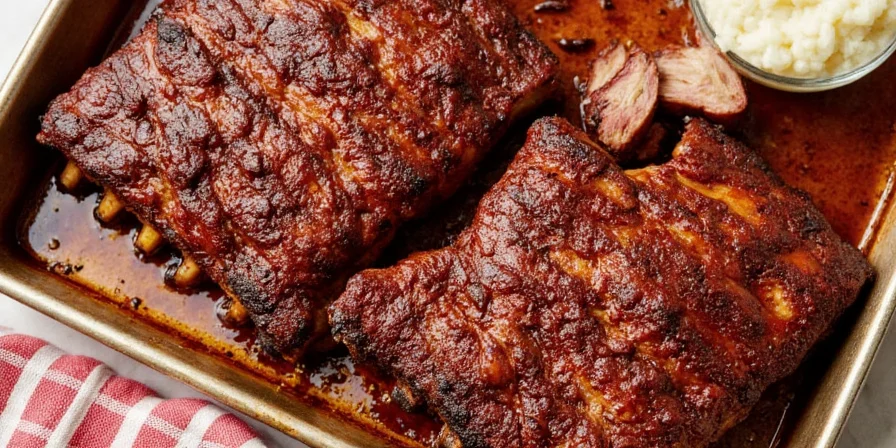
Perfect Oven-Baked Ribs Recipe: Step-by-Step Instructions
Prep time: 15 min | Cook time: 3 hours | Total time: 3h 15min | Servings: 4
How to Make Perfect Oven-Baked Ribs Without a Grill
Forget complicated equipment - you can achieve restaurant-quality ribs using just your oven with this reliable method. Follow these precise steps for fall-off-the-bone tenderness every time:
- Prepare ribs: Remove membrane, apply dry rub (12-24 hours before cooking)
- Low-and-slow bake: 275°F wrapped in foil for 2.5 hours
- Finish crisping: 400°F for 10-15 minutes to develop crust

The Foolproof 3-Step Oven Rib Method
Our tested approach delivers consistently tender results with minimal effort. This isn't just another recipe - it's the exact technique professional kitchens use when outdoor grilling isn't an option.
What You'll Need
- 1 full rack pork spare ribs (about 3 lbs)
- Avocado oil (high smoke point)
- Digital meat thermometer
- Heavy-duty aluminum foil
- Wire rack and drip pan
The Essential Oven Rib Cooking Process
Follow this timing-tested sequence for guaranteed success:
1. Preparation Phase (12-24 Hours Before Cooking)
Mix equal parts brown sugar, paprika, garlic powder, and smoked salt. Apply avocado oil to ribs, then press dry rub into meat with 3-5 lbs of pressure per square inch. Refrigerate uncovered for optimal bark formation.
2. Low-and-Slow Baking (2.5 Hours)
Place ribs bone-side down on foil, add 1/4 cup apple juice, and wrap tightly. Bake at 275°F (135°C) for 2.5 hours. This precise temperature converts collagen to gelatin without boiling out moisture.
3. Crisp Finish (10-15 Minutes)
Unwrap ribs and increase oven to 400°F (204°C). Return ribs to oven for 10-15 minutes until internal temperature reaches 195-203°F (90-95°C). This rapid temperature shift creates instant caramelization while keeping interior juices stable.
| Spice | Flavor Activation Temp | Meat Interaction | Optimal Usage Timing |
|---|---|---|---|
| Paprika | 180°F (82°C) | Binds to fat molecules | Dry rub phase |
| Brown Sugar | 320°F (160°C) | Caramelizes surface proteins | Final 45 minutes |
| Garlic Powder | 140°F (60°C) | Disulfides enhance umami | Marinade base |
| Chili Powder | 175°F (79°C) | Capsaicin solubilizes fats | Dry rub phase |
| Mustard Powder | 212°F (100°C) | Thioglucosides boost browning | Dry rub phase |
| Black Pepper | 212°F (100°C) | Piperine increases absorption | Marinade or final rub |
| Smoked Salt | N/A | Surface pyrolysis compounds | Pre-cook application |

Critical Temperature Guidelines
Temperature control is non-negotiable for perfect ribs:
- 195-203°F (90-95°C): Ideal internal temperature for fall-off-the-bone texture
- Below 190°F: Collagen remains intact (tough ribs)
- Above 205°F: Muscle fibers contract excessively (dry ribs)
- 320°F (160°C): Brown sugar caramelization point (apply sugar rubs late)
Most Common Oven Rib Mistakes (And How to Fix Them)
Avoid these frequent errors that ruin otherwise good ribs:
- Skipping the foil wrap: Essential for maintaining 100% humidity during collagen breakdown. Without it, ribs dry out even at proper temperatures.
- Applying sauce too early: Sugar burns at 320°F. Wait until internal temperature reaches 185°F for optimal results.
- Using fresh spices in rubs: Water content steams rather than sears. Always use dried spices for better bark formation.
- Over-marinating: Acidic components (vinegar, citrus) should contact meat for max 2 hours to prevent mealy texture.
- Not resting properly: 15-minute rest allows myoglobin reabsorption, preventing juice loss during serving.

Proven Timing Adjustments for Different Oven Types
Adjust these variables based on your specific equipment:
- Convection ovens: Reduce temperature by 25°F and check 20 minutes early
- Older ovens: Place an oven thermometer inside to verify actual temperature
- Thick-cut ribs: Add 30-45 minutes to foil phase
- Thin-cut ribs: Reduce foil phase by 30 minutes
- Electric vs gas: Electric ovens typically run hotter - verify with thermometer
Frequently Asked Questions
Can I skip the foil wrap when oven-cooking ribs?
No. The foil phase creates a steam environment that maintains 100% humidity, preventing surface drying while collagen breaks down. Skipping it risks tough, dry ribs even at proper temperatures.
Why does my oven rib crust lack grill-like texture?
Oven environments lack radiant heat, requiring higher final temperatures (400°F+) to evaporate surface moisture rapidly. Brushing with oil before the high-heat phase creates instant crisping through Leidenfrost effect.
How do I prevent sugar burn in spice rubs?
Apply sugar-containing rubs during the final 45 minutes only. Brown sugar caramelizes at 320°F—if exposed to higher temperatures longer, it degrades into bitter compounds.
Can I use fresh spices instead of dried in rubs?
Fresh spices contain water that steams rather than sears. Dried spices concentrate flavor compounds and lack moisture that would inhibit bark formation. For fresh flavors, add citrus zest to finishing sauce only.
What's the ideal internal temperature for fall-off-the-bone ribs?
195-203°F (90-95°C). Below 190°F, collagen remains intact; above 205°F, muscle fibers contract excessively causing dryness. Use a probe thermometer for accuracy.











 浙公网安备
33010002000092号
浙公网安备
33010002000092号 浙B2-20120091-4
浙B2-20120091-4